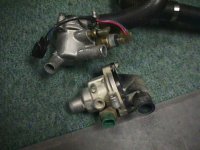LLove
Bronze Member
Roger, more food for thought.
The 1/8 inch, or larger if needed, "bleed hole" works well with high rpm engines when the OEM bypass hoses aren't enough. So the hole should work in the same way as a bypass hose if sized correctly. The thermostat also works as a restrictor to the water flow, without one the water can be forced out thru the radiator cap, given the right set of curcumstances.Of course without a thermostat you still have a thermosiphon system with or without the flow provided by the pump. And you are 100 percent correct re: horsepower is lost when compressing/pushing water, or any other load put upon the engine. Case in example... Pulled out and started to pass some cars following a slow truck, at around 5,000 rpm the radiator cap lost the war of holding the pressure at 12lbs, as the water blew out and the waterpump was relieved of it's job, it felt as thou I had gained a Nitrous Oxide boost of power. The real problem was scale build-up in the radiator.
One may try turning a water pump slower to offset the running too cold problems, and gain some of the horsepower back if it's a belt driven pump. On engines subjected to high rpm useage slowing down or even removing a couple of the fins of the waterpump is needed to allow the coolant a chance to assorb the heat better- because the flow was too fast to do so. Remember people... the coolant in the cooling system is only 70 percent of the whole cooling system. Oil = 20percent and the air flow around the engine is the last 10 percent.
The 1/8 inch, or larger if needed, "bleed hole" works well with high rpm engines when the OEM bypass hoses aren't enough. So the hole should work in the same way as a bypass hose if sized correctly. The thermostat also works as a restrictor to the water flow, without one the water can be forced out thru the radiator cap, given the right set of curcumstances.Of course without a thermostat you still have a thermosiphon system with or without the flow provided by the pump. And you are 100 percent correct re: horsepower is lost when compressing/pushing water, or any other load put upon the engine. Case in example... Pulled out and started to pass some cars following a slow truck, at around 5,000 rpm the radiator cap lost the war of holding the pressure at 12lbs, as the water blew out and the waterpump was relieved of it's job, it felt as thou I had gained a Nitrous Oxide boost of power. The real problem was scale build-up in the radiator.
One may try turning a water pump slower to offset the running too cold problems, and gain some of the horsepower back if it's a belt driven pump. On engines subjected to high rpm useage slowing down or even removing a couple of the fins of the waterpump is needed to allow the coolant a chance to assorb the heat better- because the flow was too fast to do so. Remember people... the coolant in the cooling system is only 70 percent of the whole cooling system. Oil = 20percent and the air flow around the engine is the last 10 percent.
